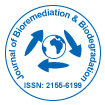Research Article
Bioremediation Potential of White Rot Fungi, Pleurotus Spp against Organochlorines
| Saima Sadiq1,2*, M. Inam ul Haq1, Iftikhar Ahmad2, Karam Ahad2, Azhar Rashid3 and Nazia Rafiq2 | |
| 1Pir Mehr Ali Shah, Arid Agriculture University, Rawalpindi, Pakistan | |
| 2National Agriculture Research Centre, Islamabad, Pakistan | |
| 3Quaid-I-i-Azam University, Islamabad, Pakistan | |
| Corresponding Author : | Saima Sadiq Pir Mehr Ali Shah Arid Agriculture University, Rawalpindi, Pakistan. Tel: 92-051-9290466 E-mail: saimasadiqqau@yahoo.com |
| Received July 06, 2015; Accepted August 15, 2015; Published August 22, 2015 | |
| Citation: Sadiq S, Inam HM, Ahmad I, Ahad K, Rashid A, et al. (2015) Bioremediation Potential of White Rot Fungi, Pleurotus Spp against Organochlorines. J Bioremed Biodeg 6:308. doi:10.4172/2155- 6199.1000308 | |
| Copyright: © 2015 Sadiq S, et al. This is an open-a ccess article distributed under the terms of the Creative Commons Attribution License, which permits unrestricted use, distribution, and reproduction in any medium, provided the original author and source are credited. | |
| Related article at Pubmed, Scholar Google | |
Abstract
White rot fungi play significant role in biological dissipation of Organochlorine (DDT, HCH, Aldrin, Dieldrin, Endrin, Endosulfan and Heptachlor) in ecosystem. Relative biodegradation potential of Pleurotus ostreatus(OST-1), Pleurotus pulmonarious (Sajor- Caju)(WC-537),Pleurotus ostreatus( WC-522), A-6 and R-22 (Pleurotus ostreatus) against above pesticides were studied by using GC-ECD. HCH was degraded 84% by OST-1 which is a local strain, followed by A-6 (55%), WC-522 (45%), OST-Belgium (29%) and WC-537 (4%) which are exotic strains of Pleurotus. Maximum Degradation of 4,4-DDT and 2,4-DDT was done by OST-1(67% and 65%)respectively. Influence of A-6 (69%), OST-Belgium (69%) and WC-537 (51%) was more pronounced for 4,4-DDT than for 2,4-DDT with only 14%, 16% and 0% respectively. Exotic strain of P. ostreatus (WC-522) was the most inefficient of the isolates and produced only 3% reduction in 2,4-DDT and no reduction was observed in case of 4,4-DDT. In the study only A-6 and OST-1 were found to produce some reduction while OST-Belgium, WC-522 and WC-537 did not produce any amount of reduction in aldrin and dieldrin quantities. Efficacy of isolates varied significantly with each other for a-endosulfan and b-endosulfan A-6 and OST-1 were found most efficient and at par with each other in reducing the amount of α-and β-endsulfan in bioassay. Mean maximum reduction of Endrin 32% was recorded in WC-537 followed by 29% in WC-522 and 14% in OST-Belgium. Isolates also vary greatly in degradation of heptachlor. Based on results it is highly recommended to use local Pleurotus isolates of Particular area where bioremediation need to be done.

 Spanish
Spanish  Chinese
Chinese  Russian
Russian  German
German  French
French  Japanese
Japanese  Portuguese
Portuguese  Hindi
Hindi 
